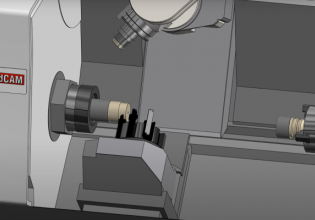An Introduction to Manufacturing Execution Systems (MES)
Let’s learn the definition, brief historical context, and architecture of manufacturing execution systems (MES).
Many modern manufacturing processes are highly automated and rely on applications and systems to manage large amounts of transactions and information. These manufacturing processes are also increasingly integrated, both vertically and horizontally.

Figure 1. Automated production and assembly line. Image used courtesy of General Motors
In many industries, rapid changes in demands and markets trending toward more customization and variety make it crucial to count on systems with close to real-time information about the production process and can adjust as needed. One of these systems is the manufacturing execution system (MES).
What is a Manufacturing Execution System (MES)?
The term MES was first defined by the Manufacturing Enterprise Solutions Association (MESA) in 1992 as follows:
“A Manufacturing Execution System (MES) is a dynamic information system that drives effective execution of manufacturing operations. Using current and accurate data, MES guides, triggers and reports on plant activities as events occur. The MES set of functions manages production operations from point of order release into manufacturing to point of product delivery into finished goods. MES provides mission critical information about production activities to others across the organization and supply chain via bi-directional communication.”
At a fundamental level, this definition remains accurate nowadays. However, the concept of MES has rapidly evolved and expanded in the last three decades. Starting with an operations-centric approach, the MES concept now includes enterprise-level and strategic business components.
To better understand where MES are now and their future trends, we need to consider how this type of system was born—which was even before the coining of the term in 1992. The history of the MES closely follows that of other applications, such as enterprise resource planning (ERP) and warehouse management systems (WMS). When looking at the broader history of the computer and its integration into industrial manufacturing, MES can be seen as one more chapter.
The History of Manufacturing Execution Systems (MES) Models
The needs were there from the beginning. In the 1970s and 1980s, several ERP applications had successfully made their way into the market and were being increasingly adopted. In parallel to this, industrial automation made tremendous advances, and programmable logic controllers (PLCs) were becoming more commonplace.
But there was a missing “link” between them. From a systems perspective, the MES essentially made it possible for two different layers of an organization to communicate: the business layer with the control and manufacturing processes.

Figure 2. An illustration of a DOS-based legacy enterprise system. Image used courtesy of IQMS
Over the years, as automation permeated nearly every manufacturing process, operative systems improved and, generally, all technologies advanced. The concept of MES evolved to integrate more functions into these processes.
MESA-11 Model
In 1997, MESA issued the “MESA-11” model, describing the MES as having the following 11 core functions.
- Operations / Detailed Sequencing
- Dispatching Production Units
- Product Tracking and Genealogy
- Labor Management
- Quality Management
- Resource Allocation and Status
- Document Control
- Performance Analysis
- Process Management
- Maintenance Management
- Data Collection and Acquisition
The Collaborative MES Model
Then, in 2004, MESA published the Collaborative MES model or c-MES. This model expanded from the previous MESA-11 and included a new layer of areas that brought attention to how the MES integrates with other business processes.
.jpg)
Figure 3. The c-MES model published by MESA in 2004. Information used courtesy of MESA
The Current Manufacturing Execution System (MES) Model
MESA issued the current model for the MES in 2008. It further expanded to include more business areas, clearly showing the interconnection between production, production operations, business operations, and strategic initiatives. In this model, the relationships between the different layers are characterized as objectives and results.
The objectives come from the top layer of Strategic Initiatives and cascade down to the bottom three layers. Conversely, the results emanate from each of the bottom three layers (the “operations” levels) and flow up to the strategies level.

Figure 4. The current model for the MES published by MESA in 2008. Image used courtesy of MESA
The MESA models—as well as other models from other organizations—help explain the role and functionality of the MES, but what does an MES application look like? How does it work?
Available Manufacturing Execution Systems (MES)
Due to the numerous functionalities attributed to the MES by its definition, there is no standardized protocol or interface for the applications. There are now hundreds of MES products available. Some of the most popular include AVEVA MES (formerly Wonderware MES), FactoryTalk by Rockwell Automation, SAP Manufacturing Execution, Hydra MES, and BlueStreak.
Many MES products can integrate upwards to the ERP via web services, typically exchanging XML-based data packages. Down to the floor level automation, virtually all major PLC brands are supported; in many cases, the OPC standard is implemented. In the last five years, some companies have begun to offer MES in the software-as-a-service (SaaS) format.

Figure 5. A diagram of how MES work in industrial facilities. Image used courtesy of AVEVA [PDF]
Interestingly, the proliferation of MES products and the penetration of cloud-based services in manufacturing give rise to a new trend of fragmentation. Businesses can now choose from different modules of the MES application, depending on what areas are deemed to justify the investment and create a highly customized solution. If this trend continues, the industry could see the rise of new software solutions that could still be considered under the umbrella of the MES or could lead to a different type of application altogether.







Very interesting article!